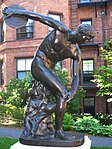Berkman Klein Center for Internet & Society
1998 establishments in MassachusettsBerkman FellowsComputer law organizationsHarvard Law SchoolHarvard University ... and 6 more
Information societyInformation technology research institutesInternet-related activismInternet governance advocacy groupsResearch institutes established in 1998Research institutes in Massachusetts
The Berkman Klein Center for Internet & Society is a research center at Harvard University that focuses on the study of cyberspace. Founded at Harvard Law School, the center traditionally focused on internet-related legal issues. On May 15, 2008, the center was elevated to an interfaculty initiative of Harvard University as a whole. It is named after the Berkman family. On July 5, 2016, the Center added "Klein" to its name following a gift of $15 million from Michael R. Klein.
Excerpt from the Wikipedia article Berkman Klein Center for Internet & Society (License: CC BY-SA 3.0, Authors).Berkman Klein Center for Internet & Society
Massachusetts Avenue, Cambridge
Geographical coordinates (GPS) Address Nearby Places Show on map
Geographical coordinates (GPS)
| Latitude | Longitude |
|---|---|
| N 42.37955 ° | E -71.11957 ° |
Address
Wasserstein Hall
Massachusetts Avenue 1585
02163 Cambridge
Massachusetts, United States
Open on Google Maps








